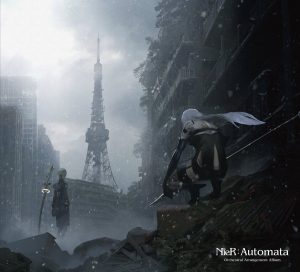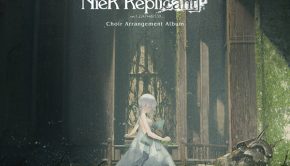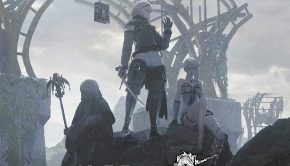NieR:Automata Orchestral Arrangement Album
 |
Album Title: NieR:Automata Orchestral Arrangement Album |
| Record Label: Square Enix Music |
|
| Catalog No.: SQEX-10674 |
|
| Release Date: September 12, 2018 |
|
| Purchase: Buy at CDJapan |
Overview
NieR:Automata Orchestral Arrangement Album is the first fully orchestral arrangement album for NieR:Automata, released simultaneously with the NieR Gestalt and Replicant Orchestral Arrangement Album. The album has separate arrangements for individual songs instead of medleys and suites. The album also features a choir for most of the tracks, only omitting it for “City Ruins” and “Weight of the World.” Most of the popular tracks from the original soundtrack are featured here, but it also happens that many of these tracks were originally orchestral to some degree, so that the arrangements here have some difficulty setting themselves apart.
Body
The album opens with “City Ruins.” The arrangement focuses on the strings, which create a lush and floaty sound that sets the track apart from its percussive originals. The whole orchestra comes together for a lovely climax, and the overall beauty of the track more than makes up for the lack of any vocals. The album continues with another area theme, “Amusement Park,” which begins with the orchestra alone before handing the melody over to the choir. It takes a straightforward path building up to a sizeable wall of sound, but this epic, militaristic character does not fit the track; a mysterious or playful arrangement would have been better suited.
The other area themes are more interesting in their interpretations. “Alien Manifestation” switches out the original’s driving percussion for flurries of strings, winds, and brass that go from hushed quivers to a tempestuous climax that feels well earned. The song even works in a new mournful strings section, giving the track emotive depth that the original lacked. “The Tower” is similar with its usage of fluttering lines, but it also makes effective use of solo instruments and smaller groupings throughout. The constant shifting of lead instruments and texture make up for its simple melodies. At no point does the arrangement try to channel the original’s whirring digital instruments, but it instead creates its own soundscape, and it does so quite successfully.
Also present on the album are a number of battle themes, which present some difficulty for arrangers as the originals are already largely orchestral. The first of these is “A Beautiful Song,” which was a highlight on the original soundtrack, but a misstep here. The choir only sings some of the melodies, leaving the rest for the strings, which aren’t as effective. The percussion here doesn’t provide enough energy, and the second half of the track is simply too redundant. Likewise, “Dependent Weakling” loses the otherworldliness provided by the original female chorus and does not bring anything substantially new to the arrangement aside from a brief section that brings out the underlying waltz elements of the piece. “Bipolar Nightmare” fares better in expanding on the sound of the original by making the arrangement busier, but the end result sounds too similar to the other battle tracks on the album. “The Sound of the End” very closely follows the original with its first half dedicated to the battle and the second half to the aftermath. The first half loses its edge as the strings don’t feel raw as the original, though the more prominent brass gives the arrangement more force. The second half is an improvement as the melody is passed between the different instruments, and it builds up again to a new ending that brings out the sense of tragedy. It is one of the better tracks on the album, though its strengths are ultimately derived from the original.
The last two tracks to be discussed are also very straightforward. “Mourning” is particularly unambitious in its arrangement, essentially reproducing the original in a higher key with some added percussion at the end to give it more weight. While the full orchestra and chorus sound much more organic and rich than the original’s, there simply isn’t enough new in this track. “Weight of the World” excludes the choir entirely, which is a bold choice given the significance of the choir in the original. It’s true that the choir might have made the arrangement feel too sentimental, but the song’s melodies are not strong enough on their own to hold one’s attention over the track length. Without any new counterpoint or harmony to flesh things out, or a strong performance from a solo instrument to captivate the listener, the track simply comes and goes without making much of an impression.
Summary
NieR:Automata Orchestral Arrangement Album is a perfectly competent set of orchestral arrangements, but it doesn’t bring enough new ideas to tracks that were already largely orchestral. Aside from “City Ruins,” “Alien Manifestation,” and “The Tower,” none of the tracks sound like they were arranged with any special vision in mind. They instead only add small modifications to the originals, or else provide a very straightforward transcription for orchestra that even loses the particular charms of the original. Despite a lack of innovation, the album is still solid on its own terms, so that fans should be able to appreciate hearing their favorite tracks in the orchestral setting where the instruments sound more rich and full.
Do you agree with the review and score? Let us know in the comments below!
3.5
Posted on June 4, 2019 by Tien Hoang. Last modified on May 31, 2019.














